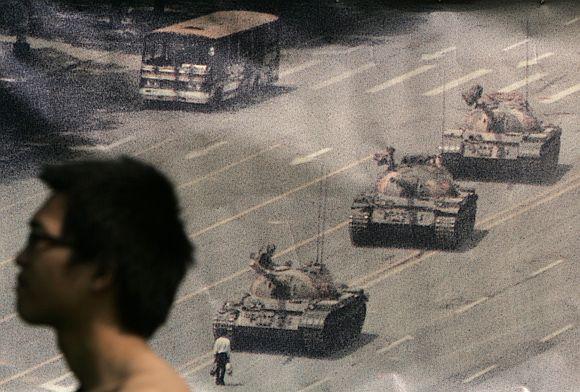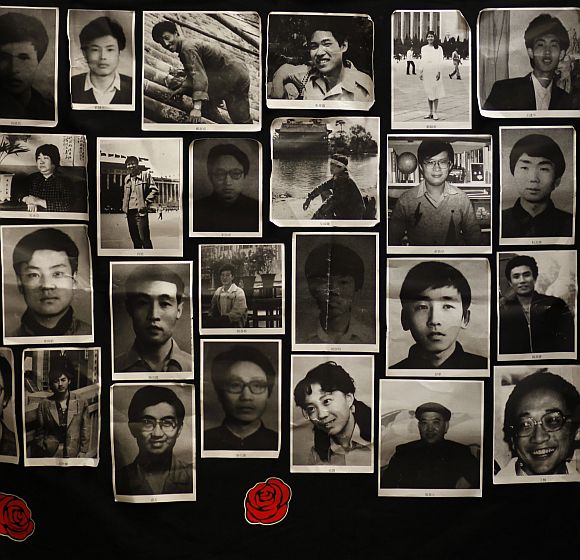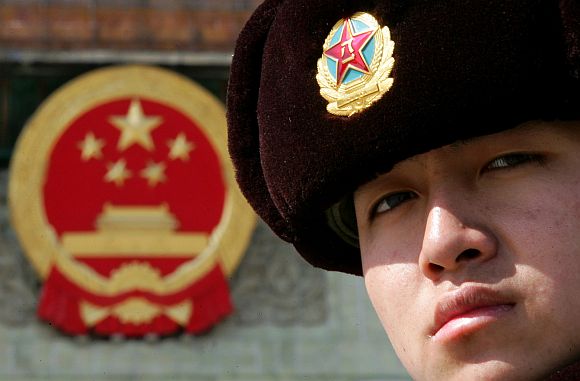Photographs: Tyrone Siu/Reuters
Thousands of Chinese are on Tuesday observing the 24th anniversary of the bloody military crackdown on pro-democracy protesters in Tiananmen Square.
We reproduce an updated version of a feature on the Tiananmen feature carried a decade ago.
Tiananmen Square is a large open space in the heart of Beijing, the area where grand parades are held, where the red-coloured Chinese flags flutter to mark important State occasions, and where, on October 1, 1949, Mao Zedong declared the foundation of the People's Republic of China. Tiannamen, in Chinese, means The Gate of Heavenly Peace.
Today, Tiananmen Square has acquired a different connotation: it remembered by many as the place where, in May-June 1989, a brave attempt was made by students to usher democracy into China; it is also remembered as the place where the Chinese leaders used tanks and guns to kill hundreds of unarmed students on June 4, 1989.
In 1989, with winds of change blowing over the Communist world (the Berlin Wall would fall that winter), a group of students had an impromptu gathering at Tiananmen Square in April 1989 to mark the death of Hu Yaobang, a Communist leader who was considered sympathetic to the demands for democracy.
...
When tanks rolled down Tiananmen Square
Image: Photos of those who died in a military crackdown on pro-democracy movement at Beijing's Tiananmen Square in June 4, 1989, are displayed at a 'June 4 Memorial Museum' inside a university in Hong KongPhotographs: Bobby Yip/Reuters
The students were joined by workers, peasants, intellectuals, and soon the media, until by middle of May they numbered 1 million. The students demanded more freedom and democracy. Some even sought multi-party democracy and elections.
Soon the gathering of students acquired a life of its own, becoming a cause celebre. Support was pouring in for the students from all over the world and parts of China, and for a brief moment, many even thought that perhaps momentous changes were in the offing. They were wrong.
The Communist leadership, clearly unnerved by the students' demand and the huge amount of sympathy they were drawing from parts of China and certainly from much of the world, especially the West, decided to strike back.
...
When tanks rolled down Tiananmen Square
Image: A Chinese paramilitary police stands guard in front of the Great Hall of the People in BeijingPhotographs: Claro Cortes IV CC/PN/Reuters
After a debate, the Chinese Communist Party decided to take a hardline, and on May 20, declared martial law and called in the People's Liberation Army to crush the nascent movement for democracy.
People's Liberation Army soldiers entered Tiananmen Square with a mandate to clear the demonstrations.
It was from the outset an uneven battle between the unarmed students and demonstrators and the heavily armed PLA troops, who also bought in battle tanks. Initially, the students believed that the soldiers would not fire upon their fellow countrymen, but they were wrong.
The PLA struck hard: soldiers opened fire and the tanks mowed into the demonstrators. Hundreds were killed and many were seriously injured.
...
When tanks rolled down Tiananmen Square
Image: Protesters sing as they take part in a candlelight vigil at Hong Kong's Victoria ParkPhotographs: Bobby Yip/Reuters
The exact tally of dead and injured remains unknown: the Chinese government says about 200 people were killed; journalists present in Beijing that day say about 1,000 were killed; the German Red Cross and Beijing residents placed the number of dead at around 3,500.
The leaders of the movement were arrested in the days after the crackdown; many were jailed and later exiled, while many fled, mostly to the US, to evade escape.
Every year, when the Tiananmen Square massacre anniversary draws near, the Chinese government increases security in and around the square to prevent any commemoration of the event or even the placing of flowers.
But that has never deterred hundreds of thousands of Chinese who dream of democracy flourishing in their country from holding rallies and ceremonies to hail the martyrs of Tiananmen Square, year after year.
...
When tanks rolled down Tiananmen Square
Image: A cut-out of a poster of the Goddess of Democracy is carried by a protester past a Chinese national emblem outside the government headquarters in Hong KongPhotographs: Tyrone Siu/Reuters
This year, the 24th anniversary, is no different.
While protests in mainland China are off-limits, tens of thousands have gathered to mark the anniversary in past years in Hong Kong's Victoria Park. The territory -- returned by the British in 1997 -- operates under a separate political system that promises freedom of speech and other Western-style civil liberties.
Families of the victims of the massacre have been barred from visiting their graves by more than a dozen Chinese police stationed outside the main 'Stone Gate' entrance to the Wanan graveyard where many of the victims are buried.
Security personnel were patrolling the narrow streets close to Beijing's Forbidden City and outside the former house of Zhao Ziyang, the Communist party secretary who was purged and held under house arrest following the protests.
Authorities have also detained or enhanced surveillance on 10 prominent dissidents, according to the Hong Kong-based advocacy group China Human Rights Defenders.
Online searches for a range of keywords on Sina Weibo, China's version of Twitter, have been blocked, from 'Tiananmen' to 'candle', which has been used to encourage digital vigils.
Click on NEXT to go further...






article